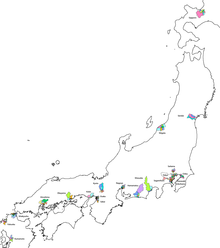Ku (Japan)
A Ku ( Japanese 区 ), often translated as a city district , is an administrative unit in some large cities in Japan , which is close to the English borough (roughly "municipality, district").
Ku form the subdivision of currently (April 1, 2009) 18 state-designated large cities ( seirei shitei toshi ) with more than 500,000 inhabitants. These shi often only emerged in the 20th century through the administrative amalgamation of several previously independent municipalities and cities that had grown together. The old communities live on in the Ku with more or less large territorial adaptations .
The Ku are local administrative units that are directly controlled by the municipal administration. You are entrusted with administrative functions such as keeping the register of residents ( Koseki , i.e. civil functions), health insurance and wealth tax . Many Ku have their own residents' organizations that carry out various tasks but do not have their own powers.
Historical ku
At the beginning of the Meiji period in 1871, a “system of large districts and small districts” ( 大 区 小区 制 , daiku-shōku-sei ) was used in which the prefectures were divided into “large districts” ( daiku ) and these in turn into “small districts” “( Shōku ) were divided.
With the Gun-ku-chō-son-hensei-hō ( 郡 区 町 村 編制 法 , "Law on the Organization of Counties, Districts, Cities and Villages") issued in 1878 , only urban areas were designated as ku . Tokyo, Kyōto and Osaka consisted of several such ku (Tokyo from 15 districts , Ōsaka from Kita-ku , Higashi-ku , Minami-ku and Nishi-ku , and Kyōto from Kamigyō-ku and Shimogyō-ku ). These cities did not have a city administration, but were ruled directly by the respective prefecture (Tokyo-fu, Kyōto-fu and Ōsaka-fu) and were therefore not independent administrative units. The following large cities were also organized as ku : Nagoya , Kanazawa , Hiroshima , Wakayama , Yokohama , Sendai , Sakai , Fukuoka , Kumamoto , Kobe , Niigata , Okayama , Nagasaki , Hakodate , Fushimi , Akamagaseki (Shimonoseki) and Sapporo . With the introduction of modern municipal system to April 1, 1889 they were ku - with the exception of Fushimi the 1881 ku status was revoked and the special case Sapporo - to shi converted, and the shi Tokyo, Kyoto and Osaka created those whose ku were subordinate .
There were exceptions in the prefecture of Okinawa and Hokkaidō , in which large cities formed later were still referred to as ku : on Okinawa between 1896 and 1921 Naha and Shuri and on Hokkaidō between 1899 and 1922 Asahikawa , Hakodate , Kushiro , Muroran , Otaru and again Sapporo . These then also became shi .
Former Tokyo Boroughs
Even Tokyo was until 1943 an independent city and was in last 35 Ku divided (see wards of Tokyo ). After the dissolution of the city of Tokyo, the districts remained and were now directly subordinate to the Tokyo Prefecture . In 1947 they were given a special form as tokubetsu-ku (“special districts”), which gave them the status of independent municipalities, but they still left some tasks such as water supply or fire brigade to the prefecture.
In the sense of Article 93 of the constitution , they were not regarded as independent regional authorities for a long time : the right to elect their own local parliaments (with legislative and tax powers) and mayors was instead granted to them by parliament . The mayors were only elected directly until 1952 and from 1975 onwards. It was not until 2000 that the Tokyo districts received formal status as "special regional authorities" ( 特別 地方 公共 団 体 , tokubetsu chihō kōkyō dantai ) within the meaning of the "Law on Local Self-Government" and thus as municipalities ( kiso-teki (na) chihō kōkyō dantai , lit. "basic regional authorities": Shi , Machi , Mura ) This was associated with a greater degree of financial autonomy, and they took on other municipal tasks, e.g. B. waste disposal by the prefecture.
